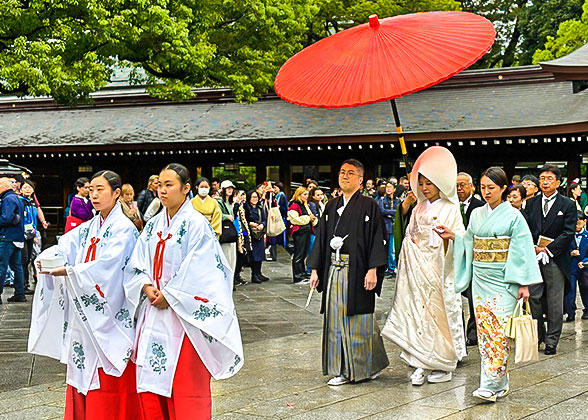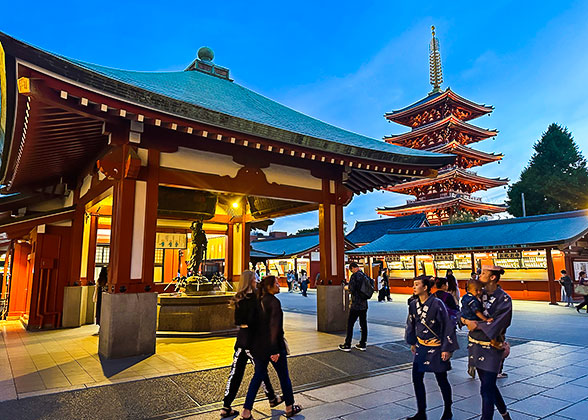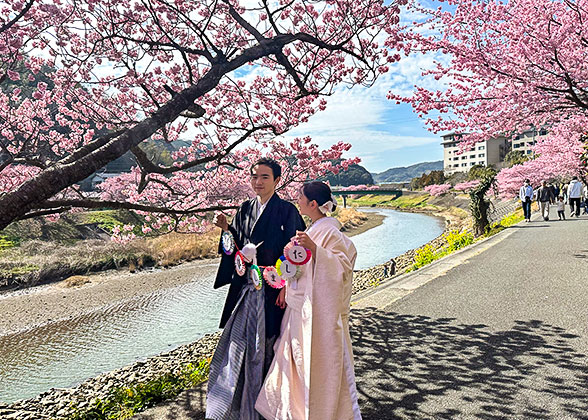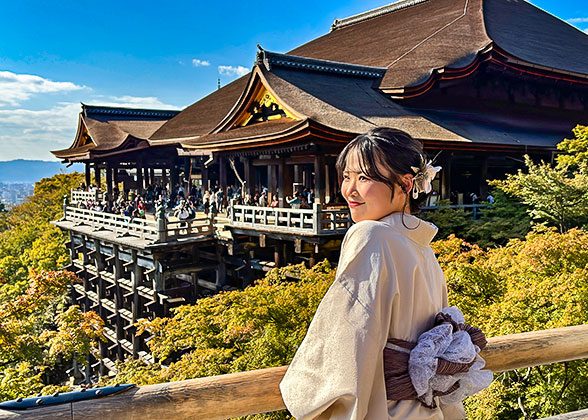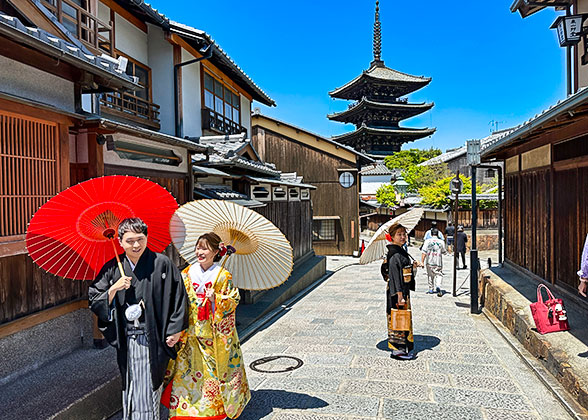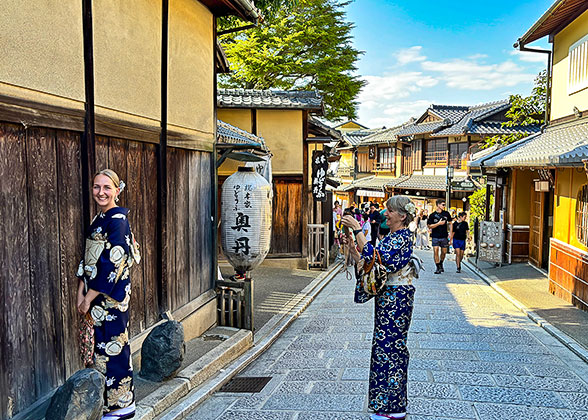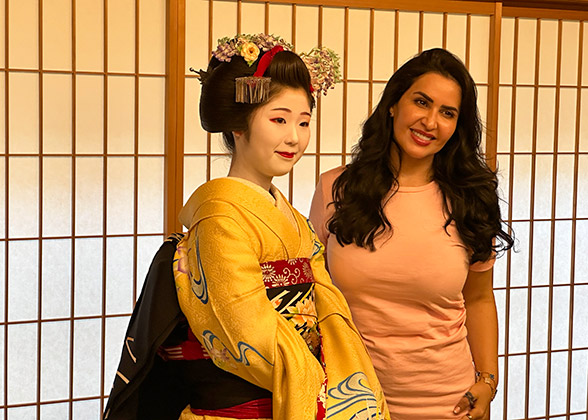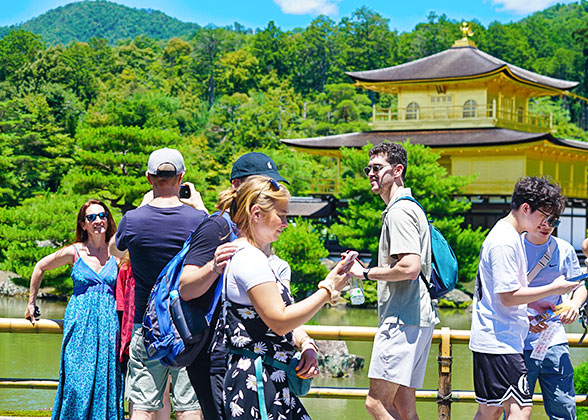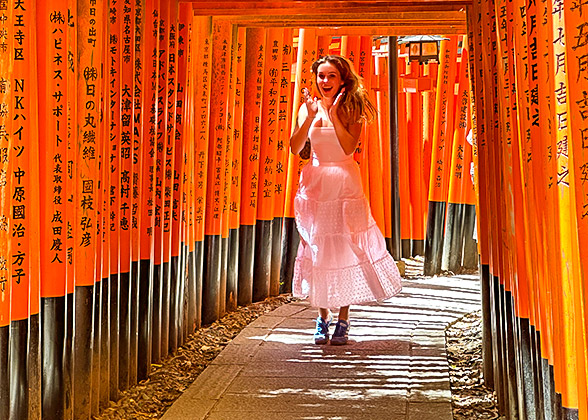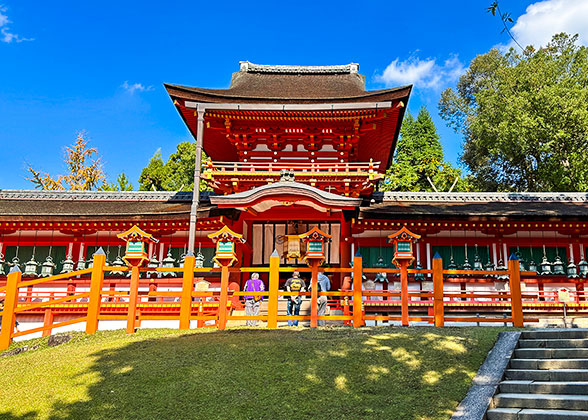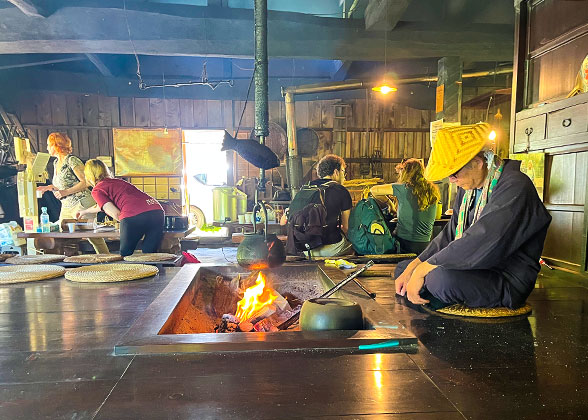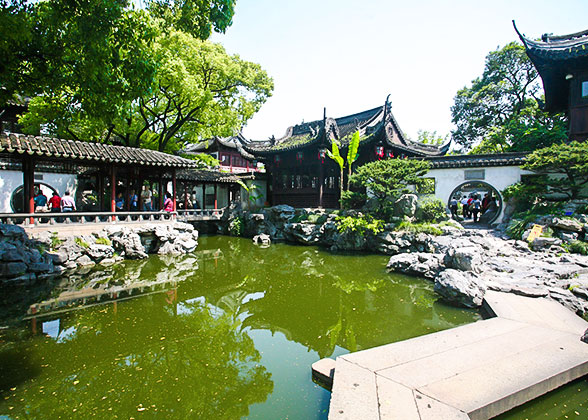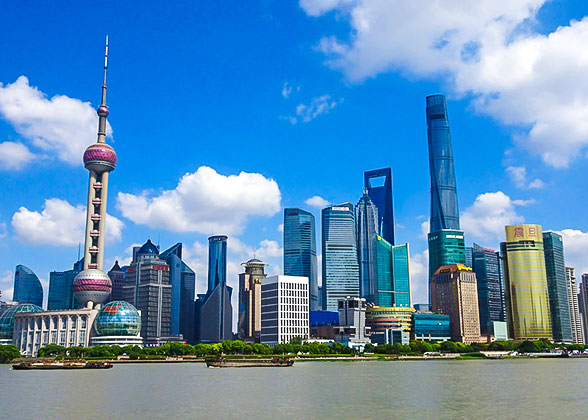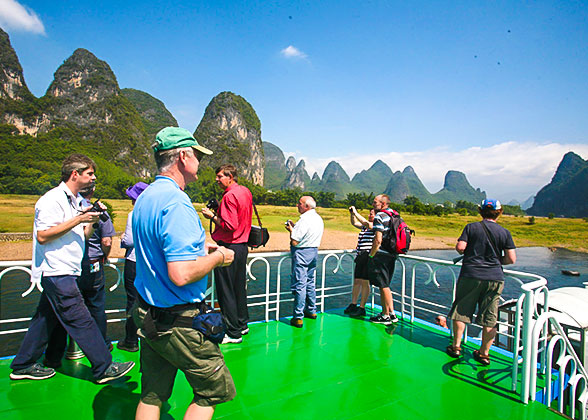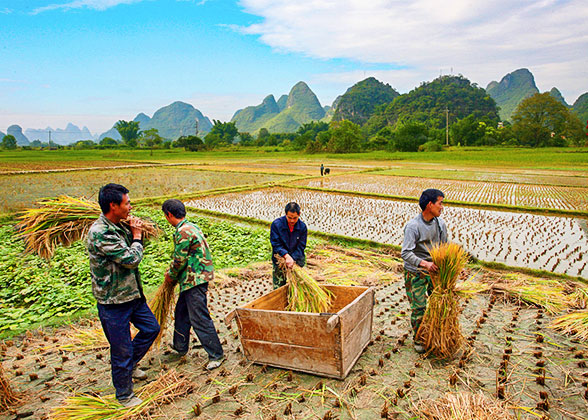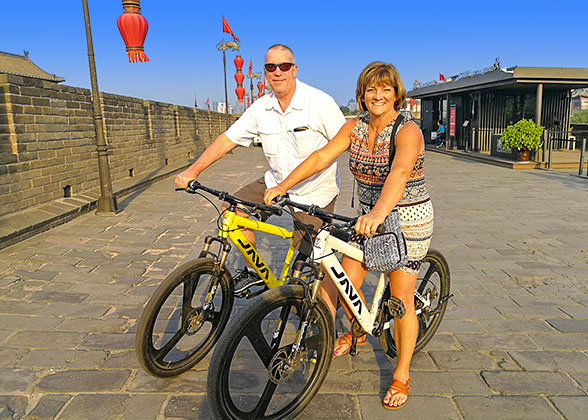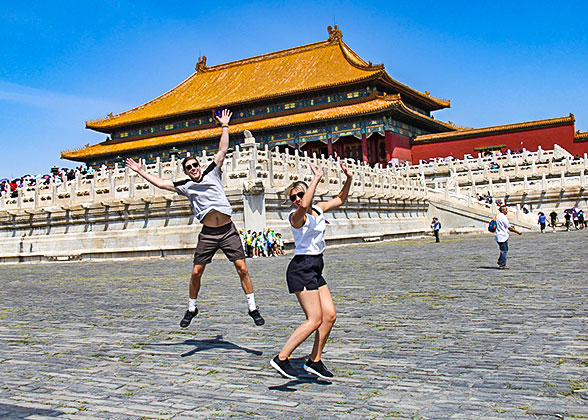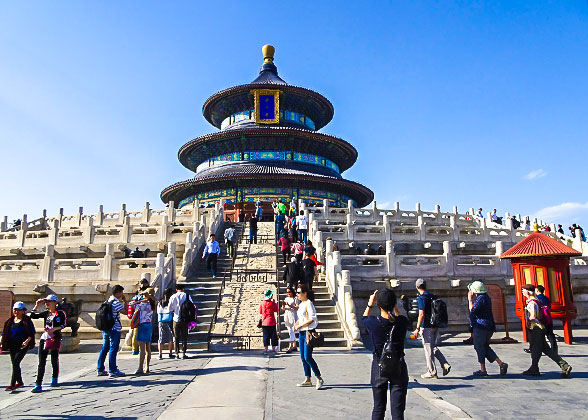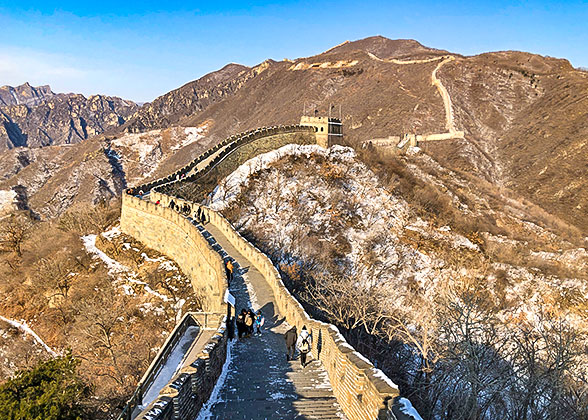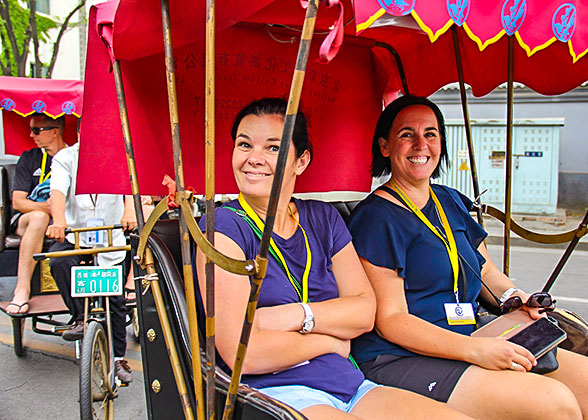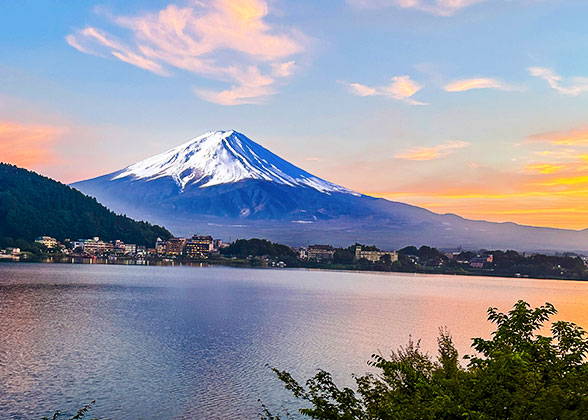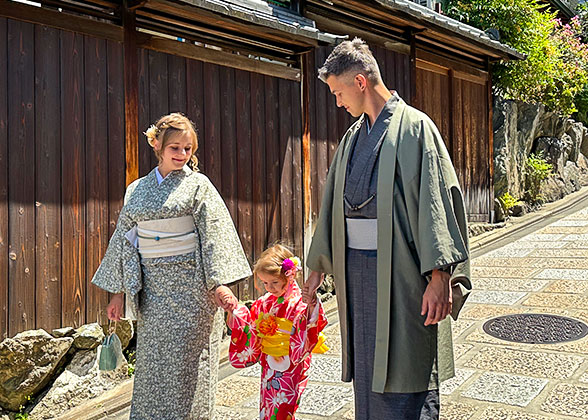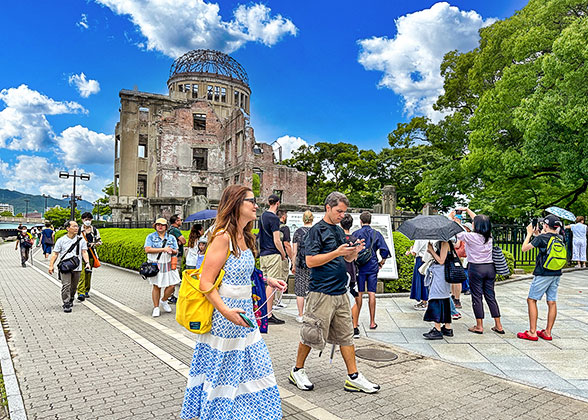Day 1: Arrival in Tokyo; Airport-hotel Transfer
Curious about East Asia? Our meticulously-designed 16 days Japan and China tours should be your definite choice! Join our expert guides to embark on a comprehensive exploration of the beautiful scenery and long history of both countries, while delve into the heart of each culture, gaining insights in comparing the differences between the two – Japan bearing well-preserved traditional culture under its modern appearance, and China with awe-inspiring vitality bursting out of its enduring legacy.
When your flight lands in Tokyo, our service ensures a seamless and stress-free arrival. An English-speaking assistant will greet you at the airport, ready to guide you to a comfortable shared car running directly to the hotel carefully selected by our experts. Unwind and settle in, or if you arrive early, venture out on your own to get a first impression of this metropolitan capital of Japan.
★ Tips from Insiders:
1. Relax in the plush surroundings of the hotel, especially its rooms above the 22nd floor, which offer excellent views.
2. Just a 10-minute walk from your hotel, Kabukicho and Golden Street, Shinjuku’s vibrant entertainment hubs, beckon with a dazzling array of dining and nightlife options.
3. Pack light and wear a comfortable pair of walking shoes, as Japan really has long walking distances and some inevitable stairs.
Accommodation: Hotel Century Southern Tower (4 stars) in Tokyo
|
Day 2: Tokyo Highlights: Meiji Jingu Shrine, Senso-ji Temple, Skytree
Meiji Jingu Shrine In the morning, our private guide will greet you in the hotel lobby, and accompany you on the eco-friendly public transport to start our Tokyo adventure. First, immerse yourself in the serenity of the Meiji Jingu Shrine dedicated to Emperor Meiji (1852 – 1912 AD). In addition to architecture and religious culture, it also features a holy venue for traditional Shinto weddings. Stay longer to witness a Japanese wedding, with solemn, reverent atmosphere, and the couple in traditional garb - the bride in white while the groom in black. Strangely quiet, with no one laughing or talking, it is a far cry from the extremely exuberant Chinese weddings with fiery red decor, and from the convivial weddings you’ve seen elsewhere in the world. Next, let’s explore the Senso-ji Temple and Asakusa area, a popular Edo-style resort. Seeing the imposing Kaminarimon Gate, which leads to the lively Nakamise-dori Street, we are approaching the temple. What would impress you is not only the antique architecture with a history of 1,400 years, but also the atmosphere very different from your stereotype of a Buddhist temple – Buddhism was introduced to Japan from China, but Japanese temples are not the same as traditional temples with contemplative ambiance, and Japanese Buddhist monks are free to consume alcohol and meat, and can even get married! The Senso-ji Temple pulsates with a unique energy – noisy, lively, and entertaining. Our guide will show you the right way to unlock the real fun things here: ► Washing: At the pool in front of the Main Hall, scoop water with a ladle in your right hand, pour it into your left hand, rinse your mouth and wash your hands to show respect. ► Fumigating: Fan the smoke from the incense burner towards yourself with your hand, which is said to relieve pain and bring good luck. ► Drawing an Omikuji fortune slip: Auspicious signs can be taken away, and if you get an ominous one, don’t worry! Tie it to the railings to ward off evil. ► Food Tasting: Try specialty snacks like Ningyo Yaki (Doll Cake), Taiyaki, and Dango in the Nakamise-dori Street. ► Rickshaw and Kimono Experience: Rent a kimono to dress up for photos or take a short rickshaw tour of Asakusa at your own expense. From Senso-ji, you can see the landmark Tokyo Skytree, the world’s tallest broadcasting tower. Our guide will take you to the foot of Skytree and show you the best spots to take photos. Prepare to be awestruck by its sheer scale and grandeur. Ascend the tower to the Tembo Deck at a height of 350 meters (1,148 feet) and take in the marvelous scenery from a 360-degree viewing gallery. Stay here as long as you like, watching the sunset over the gleaming skyscrapers, verdant parks and bustling urban life. Finally, our guide will escort you back to your hotel. Meals: Breakfast Accommodation: Hotel Century Southern Tower (4 stars) in Tokyo
|
Day 3: Tokyo to Mt. Fuji: Pirate Ship & Ropeway
Meet our guide at the hotel lobby, and then we’ll get to the Shinjuku Expressway Bus Terminal to take an express bus for 2 hours to the Lake Kawaguchi, right at the foot of Mt. Fuji. You will take the Lake Kawaguchi cruise and Mount Fuji Panorama Ropeway to see the mountain from different angles, and the guide will arrange the specific order according to the flow of people and waiting time. Board a corsair-style ship and embark on a 20-minute cruise, breathing in the cool, fresh air while taking in the elegant Mount Fuji from an unobstructed perspective. Take the ropeway to ascend the slopes of Mount Tenjo, which offers a platform with thrilling panoramic views of Mount Fuji and Lake Kawaguchi. Mount Fuji, Japan Cherry Blossom in Japan
★ Supplement: Arakurayama Sengen ParkIf time permits, we would add the Arakurayama Sengen Park for you during cherry blossom season or red leaf season. Here, you can photograph the classic scene of Mt. Fuji and the five-storied Chureito Pagoda together. Completing the visit, our guide will escort you to return by express bus to Tokyo for the night. ★ Our Unique Service: Adjustable Date to Visit Mt. FujiMt. Fuji is often shrouded in clouds due to the abundant moisture nearby, earning it the reputation of the ‘shy maiden’, which can be seen only 80 days a year. To maximize your chances of seeing the mountain, we offer an exclusive date change service. Please pay close attention to the weather forecast, discuss with our guide to swap today’s Fuji visit with the previous day’s Tokyo city tour if needed. ► Things to Know: 1. Just let us know whether you prefer a fixed date or a flexible date to visit Mt. Fuji. For a flexible date, the round-trip direct express bus is not available as the bus tickets need to be booked one month in advance. This option requires some patience - a 2 to 3 hours’ non-reserved train ride with a transfer and possibly no seats. 2. We’ll try our best to arrange your Fuji visit on a clear day, but please understand that this is not a promise. Even if you change the date, you may not be able to see the mountain clearly due to the changeable weather. Meals: Breakfast Accommodation: Hotel Century Southern Tower (4 stars) in Tokyo
|
Day 4: Tokyo to Kyoto; Visit Pure Water Temple & Gion Geisha District
Tokyo-Kyoto Train Travel on Your Own (tickets reserved and included): To maximize your sightseeing time in Kyoto, we’ll book an early train for you, departing at approximately 8:30. Please let us know if you prefer a later departure time. From your hotel, you can easily access Shinjuku Station located diagonally across the street. Here, take either the Chuo Line or Marunouchi Line for a short 15-20 minute ride to Tokyo Station. Alternatively, if you have heavy luggage, a taxi is a convenient option. Relax on the 2.5-hour bullet train journey to Kyoto. Upon arrival, our Kyoto guide will meet you at the railway station and escort you to the hotel to drop off your luggage. Embrace the grandeur of the Kyoto Tower, standing tall just beyond the bustling railway station, and then we’ll head to the Pure Water Temple, a timeless emblem of Kyoto’s millennium-old history and culture. Follow our guide to capture a cherished photograph in front of the iconic bright red Three-storied Pagoda and drink water from the Otowa Waterfall to bless your study, health and marriage. At the main hall, ascend to the majestic Kiyomizu Stage, where a panoramic vista of Kyoto unfolds before your eyes. The massive veranda is supported by a wooden frame seemingly suspended from the hillside; and surprisingly, the pillars used were built without a single nail, all made of wood with mortise-and-tenon structure. What an architectural feat! Go on to explore a nearby hidden area to wonder at a thousand stone statuettes of Bodhisattvas of the Earth brought from all over Japan. In Japanese belief, the bodhisattvas are the guardians of deceased children, and that’s why you may see some with scarves wrapped on their necks - tribute from bereaved parents. Pure Water Temple, Kyoto Sannenzaka Alleyway
★ Walking Tour of Gion: Catch the Ethos of KyotoNext, the guide will accompany you on a leisurely stroll down the gentle ramps of Sannenzaka and Ninenzaka. Lying right next to our exit of the Pure Water Temple, Sannenzaka was constructed with the purpose of blessing and guiding pregnant women to the temple to pray for safe childbirth. Now it and the adjoining Ninenzaka have evolved to a cultural block, where you may reminisce about Kyoto’s remote past. In the grocery stores that flanked the road, feast your eyes on a variety of intriguing handicrafts and gadgets, and satisfy your appetite with delectable local treats such as dango, matcha cheesecake, and matcha ice cream. Take a commemorative photo before the five-story Yasaka Pagoda of the Hokan-ji Temple, and we’ll then step into the Yasaka Shrine, where you can ring the bell and pray for good luck for your career and family. The Bigozensha Shrine inside, dedicated to three goddesses of beauty, is not to be missed. Dab your face with two or three drops of the legendary ‘beauty water’ from the pool in front of the shrine, and then your skin would become smooth and shiny. On the doorstep of the Yasaka Shrine lies the captivating Gion and Hanamikoji Street, the famous geisha district of Kyoto. The mesmerizing ambiance here would take you back in time as you wander through the antique alleys, witness the graceful ladies in kimonos walking back and forth, and the occasional geishas in exquisite costumes and white oshiroi make-up. ► Tip: If you prefer, the guide can assist you in renting a kimono set, which is very photogenic in the old style neighborhood of Gion. Our guide will escort you back to the hotel, or if you want to stay longer, just enjoy some free time here, having a Japanese kaiseki dinner and enjoying the night view, and finally take a 10-minute taxi ride back to your hotel. Meals: Breakfast Accommodation: Rihga Royal Hotel Kyoto (4 stars)
|
Day 5: Kyoto: Golden Pavilion, Nijo Castle, Kyoto Gyoen & Fushimi Inari Shrine
Today is for us to unveil the classical essence of Kyoto. After breakfast, our guide will lead you to visit the Temple of the Golden Pavilion. The name of this temple exudes an aura of nobility, as it contains a pavilion with solid gold leaves covering the eaves and walls. Emerging from the ashes of a devastating fire in 1950, the Golden Pavilion was reconstructed in 1955, surpassing its original grandeur with an even more golden resplendence, unlike the somber hues of the average Buddhist temples you might have visited. The best time to see it is at 10:00 am and sunset, so we’ve thoughtfully arranged it as the first stop of the day. The sun shines on the Golden Pavilion, which is reflected in the green pond in front of it, creating a scene particularly sacred and evocative. Next, head to the Nijo Castle, which was built on the orders of the first shogun Tokugawa Ieyasu (1543 – 1616 AD). The magnificent buildings show the authority and prestige of the general and epitomize the pinnacle of ancient Japanese architectural ingenuity. You will see that the roofs of the palaces are covered with dark thatch-like materials, in contrast to the opulent eave decorations. Is that perplexing? In fact, the early Japanese buildings were modeled after the tiled roofs of China. However, Japan’s susceptibility to earthquakes necessitated a more resilient roofing solution. Thus, Japanese architects devised lightweight roofs constructed from cypress bark, the very roofs we see today at the Nijo Castle. Around noon, delve into the 400-year-old Nishiki Market, and your taste buds will unconsciously become active and the saliva will moisten your mouth, because it is an utter foodies’ heaven! Our guide will be your compass through the market, offering expert recommendations if you’d like to try the local street food such as the salmon sushi, grilled seafood, Tako Tamago (Octopus Eggs), Takoyaki, Croquette, and Matcha Icecream. In the afternoon, check out the Kyoto Gyoen National Garden to relax with a walk in the tranquil landscaped grounds while admiring the former imperial palace. Next, head to the Fushimi Inari Shrine, where you can learn about Shinto, Japan’s indigenous religion. It is important for locals to pay homage kami Inari, who is in charge of agricultural harvest and fertility, while for tourists, the Senbon Torii seems even more attractive – a spectacular series of vermilion torii gates lining the sacred path up the Inari Mountain. Follow our guide to ascend through the channel formed by thousands of torii gates, and take great photos that will give you enough to brag about on social media for a while. Meals: Breakfast Accommodation: Rihga Royal Hotel Kyoto (4 stars)
|
Day 6: Kyoto - Nara - Osaka: Visit Nara Park & Naramachi Lattice House
Great Eastern Temple Check out after breakfast, and our guide will accompany you on a 40-minute train ride to Nara. Store your luggage at the train station, and we’ll then spend a leisurely morning in the Nara Park, exploring the World Heritage sites and playing with deer that have roamed the park for over 1,400 years, living in harmony with humans. Step into the Kofuku-ji Temple to see the Five-Story Pagoda, Southern Round Hall and National Treasure Hall. Venture onward to the Great Eastern Temple, and be struck by its colossal bronze Buddha statue, standing an astonishing 15 meters (49 feet) tall. Next, stroll along the tranquil gravel path winding to the Kasuga Taisha Shrine. Admire the approximately 3,000 stone lanterns lining the path, once offered by nobles and generals in Japanese history, testifying to the past glory of this esteemed shrine. Take an afternoon exploration into Naramachi, where the true local life unfolds. You’ll see well-preserved traditional residences, some with small gardens in the front while some with quaint shops selling hand-made snacks. Pass the Gango-ji Temple and Goryo Shrine to understand the harmonious integration of diverse faiths within the local community, and visit the Naramachi Lattice House, a quintessential Japanese residence of humble width but remarkable length. Go inside and feel the proper layout and depth of the house. Sit down in the front lobby characterized by latticed façade and imagine the host drinking tea here, pass the small but delicate patio, and look at the rear living space. Finally, the guide will escort you back to Kintetsu-Nara Station to retrieve your luggage, where you will take a half-hour train to Osaka on your own (tickets included). After arriving at Kintetsu-Nippombashi Station, walk 6 minutes southwest to your hotel. ► Osaka Free Time Suggestions: Dotonbori and ShinsaibashiUnleash your adventurous spirit as you navigate the streets of Osaka, a city pulsating with vibrant nightlife. The Dotonbori and Shinsaibashi commercial areas, within a 10-minute walk from your hotel, are the best places to go. An array of shops, theaters, restaurants, cafes and bars, with dazzling illuminated shop signs, will make your evening. The Ebisubashi Bridge above the 400-year-old Dotonbori Canal is a popular photo spot, from which you can see the Running Man billboard of Glico. Feast on gourmet restaurants and food stalls in Dotonbori, shop at Shinsaibashi, or take a boat tour along the canal to enjoy the night view for a perfect end to the day. Meals: Breakfast Accommodation: Namba Oriental Hotel (4 stars)
|
Day 7: Fly from Osaka to Shanghai, China; Airport Pick-up
► Free Morning: Recommended Self-guided Activities
If you are a history buff, it is highly recommended that you visit the Osaka Castle, one of the three historic castles in Japan. The towering castle built on a large stone base had a very strong defensive and deterrent effect in the era of cold weapons. You can see artifacts and models of historical battlefields inside the castle, reflecting the city’s epic history filled with hardships. If you want to taste local food or go shopping, then Shinsekai and Tsutenkaku are good choices.
► Transfer to Osaka Airport by Yourself:
Please leave according to the departure time of your flight. Take a taxi for 45 minutes to the Osaka Kansai International Airport at a cost of USD 130; or walk 5 minutes south from the hotel to Namba Station, and take the train Nankai Line to the airport in 45 minutes.
► Flight from Osaka to Shanghai, Pick-up by Private Car:
Take a break on the easy 2.5-hour flight (tickets reserved and airfare included). Upon landing, you will be met at the airport by our Shanghai guide, who will escort you to your hotel in our special car with private chauffeur.
★ Elevate Your China Experience:
1. Vehicle Upgrade: We’ll upgrade all of your trips in China to be served by air-conditioned private cars with experienced drivers, saving you the hassle and time of taking public transport. Enjoy the door-to-door service and ample luggage space.
2. Guide Service Upgrade: Our private tour guides, with extended service hours, will provide personalized attention and assistance throughout your journey, from the moment you step out of your hotel until you return. Experience the unparalleled value of China’s low labor costs, where you can enjoy exceptional service without breaking the bank.
3. Meal Upgrade: In addition to the daily breakfast at the hotel, we will generously provide you with 3 lunches on our China itinerary, including 2 a-la-carte lunches in Shanghai and Beijing, and a special dumpling dinner in Xi’an.
Over the next few days, unveil the profound similarities and differences between Japan and China. There is still a gap between China’s economic development and Japan’s, while the shared virtues of diligence and humility permeate both cultures. Delve into the rich historical heritage, and trace the cultural roots of Japanese architecture to its origins in China’s ancient monuments. Follow in our footsteps to experience it in person.
Meals: Breakfast
Accommodation: Sunrise On the Bund (4 stars)
|
Day 8: Shanghai City Tour: Shanghai Museum, Yu Garden, Bund & Huangpu River Cruise
Today, go straight to the People’s Square in the heart of Shanghai, where we’ll start to experience the city’s blend of rich heritage and modern vibrancy. Visit the Shanghai Museum and you'll encounter numerous masterpieces that you've never seen in Japan. Marvel at the vast collection of ancient Chinese art dating back to the 21st century BC, including bronze ware, sculptures, jade carvings, ceramics, calligraphy works, paintings, and coins. Next, the guide will show you around the 400-year-old Yu Garden, a testament to the enduring elegance of classical Chinese garden. Visit the pavilions artfully arranged amidst the man-made landscapes, and you’ll be amazed at the garden’s scale, versatility, and luxurious ornamentation, which make it hard to believe that this was ever a private garden. Afterwards, wander through the Yuyuan Bazaar outside the garden, brimming with specialty souvenirs, snacks and local life vibe, before heading for lunch. ★ A La Carte LunchAt noon, savor a la carte lunch at our carefully chosen local restaurant, the value of which is raised to CNY 150 per person (in contrast to the standard CNY 50 per person offered by other travel agencies). Consult our guide to curate a personalized dining experience, selecting dishes that tantalize your taste buds and introduce you to authentic Chinese cuisine. Yu Garden, Shanghai The Bund, Shanghai
In the afternoon, ascend to the Shanghai Tower for a panoramic view of the city from the Duo Yun Bookstore on the 52nd floor - the winding Huangpu River divides the city into two distinct yet interconnected halves. After descending, follow the guide to stroll along the Bund, Shanghai’s most visited waterfront promenade, and take a one-hour Huangpu River cruise. On the west bank, the Western-style colonial buildings on the Bund take on a golden hue in the setting sun, while to the east, the skyscrapers of Pudong, including the Oriental Pearl TV Tower, Shanghai Tower, Jinmao Tower, and World Financial Center, piercing the skyline, would impress you with the vitality of the most developed city in a developing country. Finally, our guide will escort you back to your hotel. Meals: Breakfast, A La Carte Lunch Accommodation: Sunrise On the Bund (4 stars)
|
Day 9: Fly from Shanghai to Guilin, Visit Reed Flute Cave & Elephant Trunk Hill
In the morning, our guide and the driver will escort you to the airport for a 2-hour flight to Guilin (tickets reserved and included). Our Guilin guide and the local driver will greet upon arrival. Settle into the comfort of your private car and enjoy a hassle-free transfer to your hotel.
Later, the guide will accompany you to explore Guilin city, renowned for its stunning karst landscape. Let’s begin by savoring two iconic ‘appetizers’ of the city’s natural wonders. The first is the Reed Flute Cave, a natural limestone cave formed more than 180 million years ago. Bathing in the glow of multicolored illumination, the stalagmites and stalactites make the cave look like a gorgeous crystal palace. Next, we’ll head to the city emblem site, Elephant Trunk Hill, named for its shape resembling a giant elephant drawing water from the Li River. Our smartly crafted itinerary places the visit to the hill in the golden hour of the late afternoon, ensuring that you can experience its grandeur in the most flattering light and take great photos. Get beneath the hollow of the elephant’s trunk for a look, or if you like, spend a few minutes climbing to the top of the hill, where a breathtaking vista of the Li River awaits. Have a short escorted ride back to the hotel.
Meals: Breakfast
Accommodation: Guilin Bravo Hotel (4 stars)
|
Day 10: Li River Cruise from Guilin to Yangshuo
Your journey will culminate in an unforgettable Li River cruise. In the early morning, our guide and the driver will pick you up from the hotel and escort you to the pier for a 4-hour cruise to Yangshuo. Step onto the deck and surrender to a spectacular succession of karst landscapes that will amaze you at every turn of the river. As you sail downstream, the river gradually expands, revealing a harmonious interplay between mountains and waterways, and you’ll encounter iconic landmarks that demand your attention and inspire your photographic creativity – the Mural Hill where karst formations have sculpted nine horses into the cliffside, Yellow Cloth Shoal with clear waters reflect the landscape in perfect symmetry, Xingping Town where fishermen maneuver their bamboo rafts and cast their nets into the river. ► Tip: Despite the ship’s limited culinary amenities, they still offer a simple Chinese boxed lunch for your convenience. To avoid potential disappointment with the boxed lunch, it is recommended to have a substantial breakfast at your hotel, or bring some snacks for the voyage. Li River Cruise Yangshuo Rural Scene
When the cruise arrives in Yangshuo around 14:00, our guide will accompany you on an afternoon adventure deep into the local countryside. You can choose to take a private car or ride a bicycle along the renowned Ten-mile Gallery, a scenic road that will unveil a breathtaking tapestry of rural charm. Gaze upon the bamboo rafts floating on the mirror-like Yulong River, feel flanked by the rolling hills along your biking route, meet farmers tending to their rice paddies with their trusty water buffalo, and discover a magic hill with a natural arch like the moon hanging in the sky. We’ll offer a unique opportunity for you to visit a local villager’s house and gain firsthand insights into the Chinese rural life. In stark contrast to the affluent urban life you might see in metropolitan Shanghai, there are many poor places in Chinese countryside where people live a simple life. If time permits, we’ll visit the West Street of Yangshuo before taking the private car back to Guilin for the night. Meals: Breakfast, Lunch Accommodation: Guilin Bravo Hotel (4 stars)
|
Day 11: Fly from Guilin to Xi’an, Shaanxi History Museum & Tang Dynasty Dance Show
Today, our guide and the driver will escort you from the hotel to the airport for a 2-hour morning flight to Xi’an, one of China’s most revered ancient capitals. Upon landing, our Xi’an guide will be ready to accompany you on a seamless private car transfer to your hotel.
The afternoon will be spent at the Shaanxi Provincial History Museum, a vast treasure trove that systematically displays the achievements of Chinese civilization from prehistoric times to 19th century. Unlike the ancient Egyptian and Greek artifacts and art collections that you might see in other well-known museums around the world, this museum proudly focuses on the fruits of local Chinese excavations, each of which narrates the tales of Xi’an’s past glory as the former capital of China for over a millennium. Join our knowledgeable guide to pay special attention to the exhibits from the Tang Dynasty (618 – 907 AD), such as murals, gold and silver ware, and tri-colored glazed pottery, to imagine the artistic brilliance of the Tang Empire as a world power of its time and its influence on other Asian civilizations including Japan.
★ Tang Dynasty Music & Dance Show with Dumpling Dinner
In the evening, prepare to be satiated by a sumptuous dumpling banquet at the Tang Dynasty Palace, the most prestigious theater restaurant in Xi’an, and taste China’s beloved holiday food, dumplings, enhanced by traditional music and dance performances, transporting you to a time of emperors and empresses.
There are a lot of art shows all over the world for tourists, and there are geisha and kabuki shows in Japan, but why shall we arrange for you to see this show in Xi’an? This is because Chinese shows offer artistic enjoyment and great value that worth every penny. The show excels in three aspects:
1. High Artistry: The exquisite stage design, classical costumes, makeup, and props, all restore the original Oriental traditions, bringing an immersive experience.
2. Grand Scale: A team of more than 50 actors will present you with a dance performance, with stunning live music accompaniment.
3. Photos Allowed: The last but not least advantage.
After the show, our guide and driver will take you back to your hotel.
Meals: Breakfast, Dinner
Accommodation: Holiday Inn Xi’an Big Goose Pagoda (4 stars)
|
Day 12: Xian: Terracotta Army, Giant Wild Goose Pagoda, Great Tang All Day Mall
An adventure to the BC era awaits you. This morning, we’ll visit the Terracotta Army, a massive ancient military museum built on the site of the excavation and one of China’s first World Heritage sites. Qin Shi Huang (259-210 BC), the first emperor of China’s feudal dynasties, ordered the construction of an army of terracotta sculptures to guard his tomb. Witness the thousands of life-size soldier statues, chariots and horses lining up in battle formation, and imagine the power of this once-world's-strongest army. Emperor Qin Shi Huang ended the era of warring states, establishing a unified empire that laid the foundation for Chinese social institutions for the next 2,000 years. His achievements are unparalleled, but he was also criticized for his brutality, harsh laws, and excessive taxation. However, was Qin Shi Huang really that brutal? Looking at the terracotta funerary objects, you may have a different answer. After all, human sacrifice was a common practice in that era, and the use of terracotta sculptures to replace live human sacrifice reveals the emperor’s pioneering thinking and reverence for life. ★ Special Experiences:1. Visit Discoverer of Terracotta Army: Go to the discoverer’s home and chat with this octogenarian or his family to learn more about the details of his discovery of pottery fragments while digging a well in 1974. 2. Craft a Mini Terracotta Warrior: With the guidance of a local artisan, you can create your own miniature terracotta warrior, using the same clay as the originals. Engrave your unique insignia and bring it home. Terracotta Army, Xi'an Xi'an City Wall
In the afternoon, a mere hour’s drive back to the downtown will transport you over a millennium back as we arrive at the Da Ci'en Temple, which was established in 648AD by Emperor Gaozong of Tang in memory of his beloved mother, Empress Zhangsun, who passed away during his childhood. Visit the Giant Wild Goose Pagoda inside, erected by the eminent monk Xuanzang, who dedicated himself to translating Buddhist sutras and spreading Dharma here. After an arduous pilgrimage to India, Xuanzang brought back eight Buddha statues, hundreds of pattra-leaf Sanskrit sutras, and tens of thousands of sariras. But where are these treasures? It is said that they are hidden in an underground palace that has yet to be excavated. Next, we’ll explore the Great Tang All Day Mall. Immerse in the Tang Dynasty atmosphere when strolling among the red antique buildings and seeing people in traditional Hanfu dresses. Enjoy the live performances here and there. The Tang Dynasty’s prosperity and cultural influence inspired many Asian countries. At that time, Japan sent delegations to China many times and brought back advanced technologies, culture and customs. That’s why in Japan you can see architecture similar to China. Finally, the guide will escort you back to the hotel. ► Tips for the Night:1. The vibrant atmosphere of the Great Tang All Day Mall intensifies as the lights come on. If you want to stay longer, just discuss with our guide, and finally take a taxi back to the hotel by yourself. 2. Be prepared to meet crowds, as this place is very popular, especially at night and during holidays. 3. There are many Hanfu (traditional Chinese clothes) shops nearby. If you are interested, you can rent one to wear for taking photos. Meals: Breakfast Accommodation: Holiday Inn Xi’an Big Goose Pagoda (4 stars)
|
Day 13: Xi’an City Wall and Muslim Quarter, High Speed Train to Beijing
Today, we’ll first visit the 600-year-old Xi’an City Wall of the Ming Dynasty. Its colossal scale, with a circumference eight times that of Japan’s Nijo Castle, is sure to leave you in awe. Walk through the City Wall Park surrounding the wall, where you can see locals practicing tai chi, dancing, and playing table tennis. Ascend the wall and let our guide unravel the secrets of the ingenious design of the fortifications – the moat, gate towers, arrow towers, and enemy towers combine to form a sophisticated defense system.
Next, head to the very center of the city, where you’ll see the ancient Bell Tower and Drum Tower from outside, and then enter the nearby Muslim Quarter, the largest Muslim community in a Chinese city. Visit the Great Mosque, a hidden gem tucked away in a narrow alley. Unlike the mosques you have seen in other countries, this mosque harmonizes Han Chinese architectural features with Islamic traditions. Despite the architectural blending, the Muslim faith remains deeply respected and preserved. For centuries, Muslims have chosen to make this prime location in Xi’an their home, establishing thriving businesses, mainly offering delectable homemade halal food. You can wander around at your own pace, picking your favorite food to try. The Crumbled Flatbread in Beef Stew, Kebabs, and Cold Noodles are some of the most popular dishes here.
After that, the guide and the driver will escort you to the train station for a 5-hour high-speed train to Beijing. When you arrive, it will be dark. Don’t worry, and our Beijing guide and driver will meet you and escort you to the hotel.
Meals: Breakfast
Accommodation: Beijing New World Centre Tongpai Hotel (4 stars)
|
Day 14: Beijing: Tian'anmen Square, Forbidden City, Yonghe Temple, Temple of Heaven
Today, we’ll explore the historical heritage of the Beijing, China’s capital for over 800 years. Begin with a morning walk at the Tiananmen Square, the heart of Beijing, and the venue for state ceremonies, parades, and rallies. Admire the monuments around the square, including the Tiananmen Tower, Great Hall of the People, and Memorial Hall of Chairman Mao. Next, journey back 600 years to the Forbidden City, the largest imperial palace complex in China with rigorous layout and lavish decor, and once home to over 20 emperors and their families from the 15th to the early 20th century. It covers an area of 72 hectares, with a built-up area of an astonishing 15 hectares, even larger than the Palace of Versailles in France, while 6 times the size of the Imperial Palace of Japan. Standing in awe before the magnificent Hall of Supreme Harmony, you won’t help but think that the grandeur and luxury came from the exploitation of the feudal dynasties’ tyrannical rulers on the people. Every palace rests upon the bedrock of sacrifice, soaked with the sweat, tears, and even lives of the craftsmen. At noon, an a la carte lunch is waiting for you in a highly-rated restaurant. After lunch, the guide will lead you to visit the Yonghe Temple built in the early 17th century, a lamasery adorned with red walls and golden tiles, the same color scheme as the Forbidden City. Originally a prince residence, it became an imperial temple to handle the Tibetan Buddhism affairs. Afterwards, visit the Temple of Heaven, an ancient royal sacrifice site where emperors once performed ceremonies to worship the deities of heaven, earth, and grains, praying for good weather, harvest, and national peace and security. Finally, you will be escorted back to the hotel. Meals: Breakfast, A La Carte Lunch Accommodation: Beijing New World Centre Tongpai Hotel (4 stars)
|
Day 15: Beijing: Visit Mutianyu Great Wall, Bird’s Nest, Hutong
In the morning, meet our guide in the hotel lobby and relax on a 1.5-hour private car ride to the Mutianyu Great Wall. In ancient China, the central regime built a super-long defensive wall on the mountains to resist the harassment of nomadic tribes in the north. The wall is said to be the only human-made structure visible from space. The initiator of this huge project was Emperor Qin Shi Huang, the owner of the Terracotta Army we encountered in Xi’an, while the Great Wall we see today in Beijing is mostly built by the Ming Dynasty in the 14th century. We’ll arrange a round-trip cable car for you to easily get on the wall to enjoy the scenery. Then stretch your legs for a short hike to explore some watchtowers. Overlook the walls winding through the distant mountains, like a majestic dragon. In the afternoon, return to the downtown, passing through the Olympic Park, giving you a glimpse into the city’s multifaceted soul. Here, we’ll take a photo stop and admire the modern sports venues of the Bird's Nest (National Stadium) and the Water Cube (National Aquatics Center) from outside. Finally, follow our guide into the old Beijing residential area, the Hutongs. Take a rickshaw ride through the maze of Hutong alleys to experience the real folk life. ★ Special Experiences: Visit a Local Family in HutongUnlike Japanese neighborhoods, the Hutongs are crowded, with more convenience and vitality, yet lacking tranquility and leisurely pace. As you navigate the alleyways, you can see many traditional courtyards – some demolished, some preserved, some converted into guesthouses or bars, some may conceal opulent mansions, while others are small and humble. If you don’t see it with your own eyes, it would be hard to believe that in such a prosperous city, there are still families living in cramped 10-square-meter dwellings. Even more incredible is that such modest houses command extraordinary prices, some surpassing USD 15,000 per square meter! We will invite you to visit a local family. See their house, engage in heartwarming conversations, share stories, and gain a deep understanding of their way of life. The intimate interaction will leave a lasting mark on your memory. Meals: Breakfast Accommodation: Beijing New World Centre Tongpai Hotel (4 stars)
|
Day 16: Visit Summer Palace, Beijing Airport See-off
Pack your luggage and check out, and our guide and driver will pick you up. First, we will head to the Summer Palace, a large imperial garden for ancient emperors to rest or escape the heat of summer. Visit the halls where the emperors conducted government affairs and rested, and then immerse yourself in the breathtaking vistas of the Longevity Hill, Kunming Lake, and Seventeen-Arch Bridge, just like the emperors once did. The vast expanse of water here moderates the temperature, making it more agreeable than the Forbidden City in the summer. Then, you will be escorted to the airport for your homebound flight. We hope you've had a memorable and enriching experience. Farewell, and thank you for your trust!
Meals: Breakfast
|

